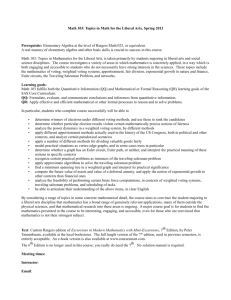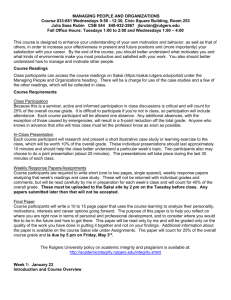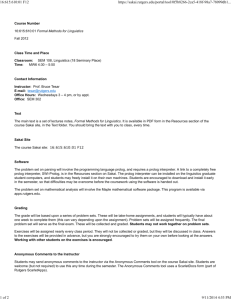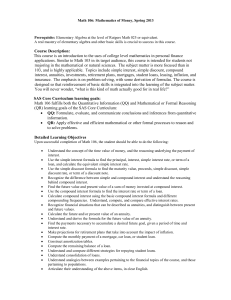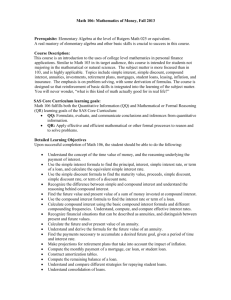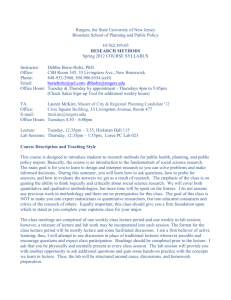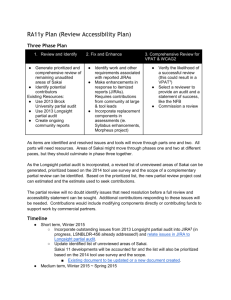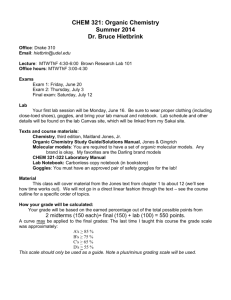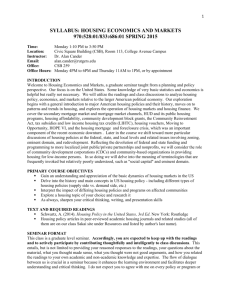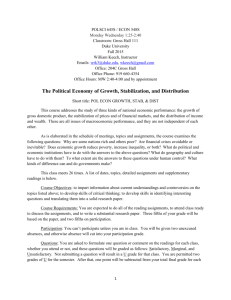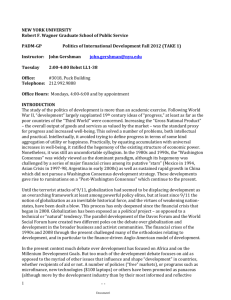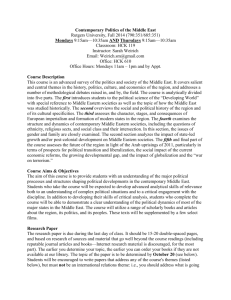Topics in Math for the Liberal Arts, Fall 2013
advertisement
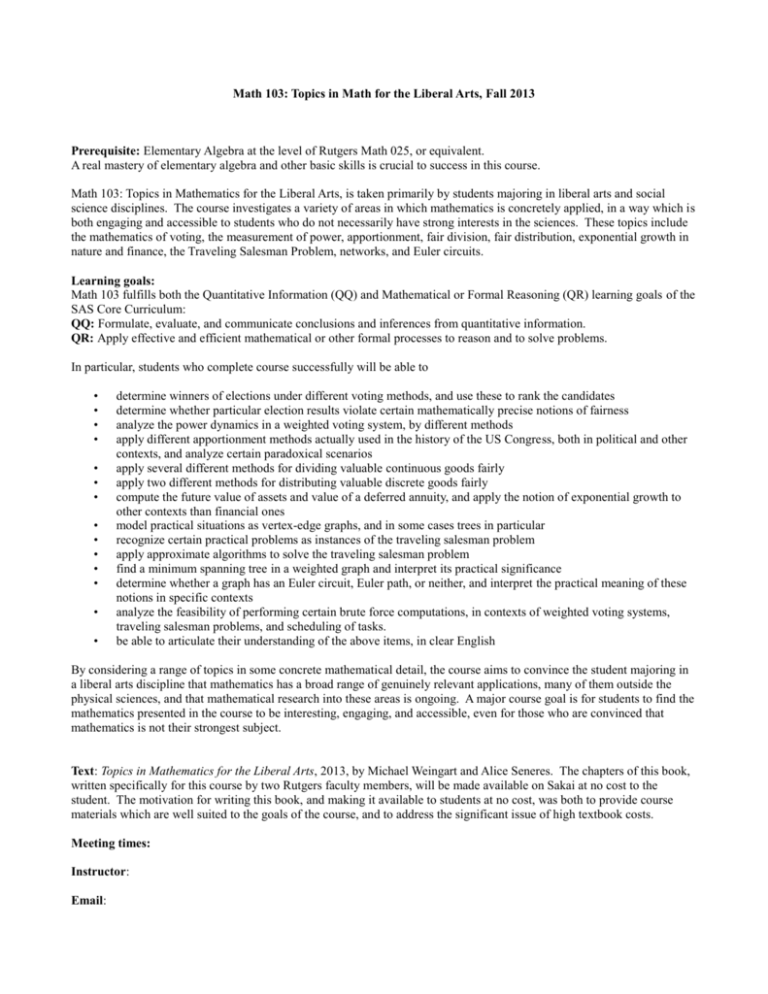
Math 103: Topics in Math for the Liberal Arts, Fall 2013 Prerequisite: Elementary Algebra at the level of Rutgers Math 025, or equivalent. A real mastery of elementary algebra and other basic skills is crucial to success in this course. Math 103: Topics in Mathematics for the Liberal Arts, is taken primarily by students majoring in liberal arts and social science disciplines. The course investigates a variety of areas in which mathematics is concretely applied, in a way which is both engaging and accessible to students who do not necessarily have strong interests in the sciences. These topics include the mathematics of voting, the measurement of power, apportionment, fair division, fair distribution, exponential growth in nature and finance, the Traveling Salesman Problem, networks, and Euler circuits. Learning goals: Math 103 fulfills both the Quantitative Information (QQ) and Mathematical or Formal Reasoning (QR) learning goals of the SAS Core Curriculum: QQ: Formulate, evaluate, and communicate conclusions and inferences from quantitative information. QR: Apply effective and efficient mathematical or other formal processes to reason and to solve problems. In particular, students who complete course successfully will be able to • • • • • • • • • • • • • • determine winners of elections under different voting methods, and use these to rank the candidates determine whether particular election results violate certain mathematically precise notions of fairness analyze the power dynamics in a weighted voting system, by different methods apply different apportionment methods actually used in the history of the US Congress, both in political and other contexts, and analyze certain paradoxical scenarios apply several different methods for dividing valuable continuous goods fairly apply two different methods for distributing valuable discrete goods fairly compute the future value of assets and value of a deferred annuity, and apply the notion of exponential growth to other contexts than financial ones model practical situations as vertex-edge graphs, and in some cases trees in particular recognize certain practical problems as instances of the traveling salesman problem apply approximate algorithms to solve the traveling salesman problem find a minimum spanning tree in a weighted graph and interpret its practical significance determine whether a graph has an Euler circuit, Euler path, or neither, and interpret the practical meaning of these notions in specific contexts analyze the feasibility of performing certain brute force computations, in contexts of weighted voting systems, traveling salesman problems, and scheduling of tasks. be able to articulate their understanding of the above items, in clear English By considering a range of topics in some concrete mathematical detail, the course aims to convince the student majoring in a liberal arts discipline that mathematics has a broad range of genuinely relevant applications, many of them outside the physical sciences, and that mathematical research into these areas is ongoing. A major course goal is for students to find the mathematics presented in the course to be interesting, engaging, and accessible, even for those who are convinced that mathematics is not their strongest subject. Text: Topics in Mathematics for the Liberal Arts, 2013, by Michael Weingart and Alice Seneres. The chapters of this book, written specifically for this course by two Rutgers faculty members, will be made available on Sakai at no cost to the student. The motivation for writing this book, and making it available to students at no cost, was both to provide course materials which are well suited to the goals of the course, and to address the significant issue of high textbook costs. Meeting times: Instructor: Email: Office hours: Calculator: A basic calculator will be needed for both homework and examinations. Computers and calculators with typewriter keyboards or built-in computer algebra systems, such as the TI-89 and TI-92, will not be permitted on exams. Online resources: This course makes extensive use of Sakai, accessible at sakai.rutgers.edu; login with your ordinary Rutgers NetID and password. Students in all sections will need to use Sakai to access the textbook, to submit their homework and view feedback on it, and to view fully worked out solutions to the homework problems. Some sections will make additional use of Sakai, as a way of posting announcements, exam review materials, or grades. Some will also use the Chat Room for online discussions about the subject matter of the course. Academic Integrity: All Rutgers students are expected to be familiar with and abide by the academic integrity policy (http://academicintegrity.rutgers.edu/academic-integrity-at-rutgers). Violations of the policy are taken very seriously. Homework: There will be at least two homework assignments for each chapter, and possibly more. Due dates for each assignment will be indicated on Sakai. Since the solutions to each homework assignment will be posted in the Resources section of Sakai shortly after the assignment is due, late homework will not be accepted. All written work must be submitted online via the Assignments area of Sakai; it may not be submitted on paper, nor by email. There are no exceptions. Important guidelines for submitting homework: 1. To access Sakai, be sure that you have an active email account and know your NetID and password. 2. The order of the homework problems in your submitted work should be the same as the order in which they are listed in the assignment on Sakai. 3. If you upload a file, it must be in one of the following formats: .doc, .docx, .pdf, or .jpg. Files which are not in this format, and which the instructor cannot open, will be given a grade of 0. 4. If you need to scan your homework assignment, the campus computer labs and libraries do have scanners, and there are technical assistants there if you need help. Note: Scanned documents should be saved as pdf files. 5. A popular technique for producing images of handwritten work is to photograph each page, or each half of each page, using a cell phone. This is acceptable. 6. It is entirely your responsibility to make certain that the file you upload has the appearance you intend. Please check this by opening the file after you have uploaded it, and see that it does open, that the image is right side up and generally readable, etc. If the file format is incorrect or the image is blurry, you will be given a grade of 0. 7. If you ever have technical difficulties with Sakai, especially in uploading homework, please contact the excellent and very responsive Sakai help desk at sakai@rutgers.edu or 848-445-8721. 8. Do not wait until the last hour to upload your homework, since the system may be unexpectedly busy. 9. Whether you upload a file or type your answers into the textbox, be sure to hit “submit” at the bottom of the screen to submit your assignment. 10. You will very quickly get a confirmation email from the Sakai system that your assignment was submitted. Make sure that you get this confirmation email, because it is your responsibility to make sure that your submission goes through. 11. If you do not receive the confirmation email, your work probably did not go through, in which case you should log back in to confirm that your work was posted, and if it wasn’t posted then you should resubmit. Unless specified otherwise, you must write your answers in complete, grammatically correct English sentences. Being able to do this is a crucial aspect of quantitative literacy, which goes beyond mere computational proficiency. Doing the homework is crucial to learning the subject thoroughly, and the system of electronic submission makes it possible for you to get feedback quickly on whether you have done the homework correctly. You are permitted, and in fact encouraged, to work together on homework problems, but all written work which you submit must ultimately be your own. Quizzes: [at the discretion of the instructor] Exams: There will be two midterm exams and a comprehensive, cumulative final exam. Missing an exam is a serious matter, and should only occur as a result of a genuine, verifiable emergency situation. "Verifiable" means that there should be a doctor's note, notice of court appearance, etc. indicating that you were unable to attend at the time of the exam. If circumstances beyond your control prevent you from attending an exam, it is important that you contact the instructor as quickly as possible. Makeups: There are no makeup quizzes or exams. As noted above, under truly compelling circumstances an absence from a quiz or exam can be excused, but instead of having a makeup, the portion of the final exam pertaining to the content of the missed midterm exam will count correspondingly more heavily. Date and time of the final exam: [see scheduling.rutgers.edu/fallfinals.shtml] Grading: The overall course grade will be based on the results of the exams, written homework, and quizzes given in class, according to the following scheme: Homework and quizzes 20% Midterm Exam 1 20% Midterm Exam 2 20% Final Exam 40% Attendance, and the classroom setting: You are expected to attend all class meetings, whose content will go far beyond a mere rehashing of the textbook. If you entertain the notion that you can succeed in the course by learning the material on your own, please think again. Here is some good news about the classroom setting, and the value of the learning experience you will have there: the cell phone of the person next to you will not ring or vibrate during class, nor will he/she engage in the very distracting activity (to self and others) of sending or viewing text messages or surfing the internet during class, nor will he/she distract you by talking (other than to participate in the class itself). This is excellent news for you, and everyone else, since you have all paid a significant amount of money to be here, and there are ample opportunities for conversation and texting and updating Facebook pages outside of class time. Caution: The information in this syllabus is subject to change, as announced in class or via email/Sakai. No major changes are anticipated, but you are expected to attend class and check email regularly. Extra help: If you are having difficulty, please take advantage of the opportunity to visit office hours. Do not hesitate to ask questions by email, or in the Sakai Chat Room. The Rutgers Learning Centers also provide drop-in, free tutoring for Math 103, according to a schedule accessible at http://lrc.rutgers.edu/content/tutoring. A few friendly words of advice: Never fall behind in a math course!!!!! The ideas we will discuss need time to sink in, and are very difficult to learn quickly right before an exam, so it is important to clear up your confusions sooner rather than later. An excellent way to improve your understanding of the subject is to study and work on homework together with classmates. Explaining mathematical ideas to others is often the most effective way to sort out your own confusions and clarify your understanding; you don't know just what it is that you don't know until you try explaining it to someone else. You are also warmly invited to ask questions in class, which students are far too hesitant to do in math courses, or in office hours, or by email, or in the Sakai Chat Room! I very much want you to succeed in this course.

